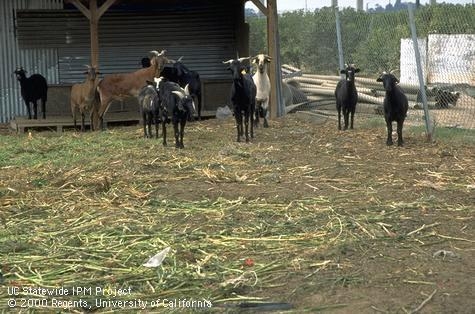
Posts Tagged: goat
UCCE Resources to Assist with Calculating Forage Loss From Wildfire
For those of you that have been impacted by past or current wildfires in relation to loss of rangeland forage, the YouTube video link and related website below would be good resources to review to help calculate forage loss. If you know of anyone with grazing lands impacted by the 2020 fires, please distribute. Also any of you that have current loss of structures, fences, stock and forages, it is always helpful to hear from you so we can summarize (without identifying individuals) to share with policy-makers. This information is often used to request federal disaster funds. Thanks in advance and stay safe!
https://ucanr.edu/sites/forageloss/
USDA decides to ditch additional rules for organic livestock producers
The following is a re-post from the trade journal Meating Place. 
USDA announced the agency has decided to withdraw the Organic Livestock and Poultry Practices (OLPP) final rule published on January 19, 2017. The withdrawal becomes effective May 13, 2018.
The rule would have increased federal regulation around animal housing, healthcare, transportation and slaughter practices of livestock and poultry for certified organic producers and handlers.
According to USDA, significant policy and legal issues were identified after the rule published in January 2017.
“After careful review and two rounds of public comment, USDA has determined that the rule exceeds the Department's statutory authority, and that the changes to the existing organic regulations could have a negative effect on voluntary participation in the National Organic Program, including real costs for producers and consumers,” an agency news release stated.
“The existing robust organic livestock and poultry regulations are effective,” said USDA Marketing and Regulatory Program Undersecretary Greg Ibach. “The organic industry's continued growth domestically and globally shows that consumers trust the current approach that balances consumer expectations and the needs of organic producers and handlers.”
Among other things, the rules would have stopped organic poultry producers from using screened-in “porches” to house birds and required them instead to provide organic poultry with outdoor access.
Organic group pursues legal options
Last week, the Organic Trade Association requested that oral arguments be heard in the lawsuit it filed last September against USDA over its failure to put into effect the (now dismissed) new organic livestock standards. Before today's decision to withdraw the rule, USDA had delayed implementation multiple times since the January 2017 final rule.
Reacting to today's news, OTA Executive Director and CEO Laura Batcha said, "This most recent egregious attempt by the Department to ignore the will of the organic industry and consumers does not halt the Organic Trade Association's seeking judicial review, but in fact furthers our resolve.The Organic Trade Association will be immediately amend the complaint to yet again challenge USDA”s latest attempt to kill a rule that has been fully vetted over a decade."
Applegate, the nation's leading natural and organic prepared meat products company, had also supported the rules.
“Our company is harmed by competition from organic livestock products that are not meeting the highest organic welfare standards,” said Gina Asoudegan, Applegate's vice president of mission and innovation strategy. “The absence of a consistent national standard for organic livestock products and its associated additional costs harm consumers in the form of higher prices.”
The American Society for the Prevention of Cruelty to Animals, The Humane Society of the United States and The Animal Welfare Institute had also supported the now dismissed rules.

tumblr inline mrpfzcdJnD1r3bfh0
USDA Report: More Slaughter Plants Needed for Direct and Local Sales
The following is a repost from the American Sheep Industry Weekly.
Demand for locally sourced products in the United States has increased in recent years, but producers often claim that a lack of slaughter facilities is a key reason that it is not expanding more quickly, writes Chris Harris.
According to a new report from the U.S. Department of Agriculture's Economic Research Service, although the share of total U.S. agricultural products sold through local food markets is small - direct-to-consumer sales accounted for 0.4 percent of total agricultural sales in 2007 - it continues to develop.
According to the 2007 Census of Agriculture, direct-to-consumer marketing amounted to $1.2 billion in 2007, compared with $551 million in 1997, a growth of 118 percent, the report, Slaughter and Processing Options and Issues for Locally Sourced Meat by Rachel J. Johnson, Daniel L. Marti and Lauren Gwin said.
The 2007 numbers are the most recent available from the Census of Agriculture, as the 2012 census is currently being carried out.
The percentage of livestock operations selling product directly to consumers or retailers is much smaller than that for other agricultural products. In 2007, only 6.9 percent of livestock operations participated in direct sales, compared with 44.1 percent of all vegetable and melon farms.
The report said that limited slaughter and processing capacity is often cited, particularly by producers, as a key barrier to marketing their meat and poultry locally.
This report looks at the slaughter and processing capacity and options available to livestock producers selling into local markets. Read the report at www.ers.usda.gov/publications/ ldpm-livestock,-dairy,-and-poultry-outlook/ldpm216-01.aspx.
What is the world's most popular meat?
I’ll bet a lot of you guessed chicken or pork. Some of you probably thought beef. Surprise! In the United States, we tend to consume chicken as our white meat of choice and beef as our red meat, but 63 percent of the world's population eats goat meat. Interestingly, more and more goat meat is being consumed in the United States and not just as an ethnic dish due to the growing ethnic population. The health-conscious consumer is also looking at the benefits of incorporating either cabrito (a delicacy meat from goats that are harvested between 1 to 3 months of age and weigh less than 50 pounds) or chevon (goats that are harvested between 6 to 9 months of age and weigh between 50 and 75 pounds). Older goat meat is also consumed but usually as sausage or in chili.

The table below shows the nutrient comparison of goat meat to traditionally raised chicken, beef, pork and lamb.
|
Nutrient composition of goat and other types of meat1, 2 |
|||||
|
Nutrient |
Goat |
Chicken |
Beef |
Pork |
Lamb |
|
Calories |
122 |
162 |
179 |
180 |
175 |
|
Fat (g) |
2.6 |
6.3 |
7.9 |
8.2 |
8.1 |
|
Saturated Fat (g) |
0.79 |
1.7 |
3.0 |
2.9 |
2.9 |
|
Protein (g) |
23 |
25 |
25 |
25 |
24 |
|
Cholesterol (mg) |
63.8 |
76.0 |
73.1 |
73.1 |
78.2 |
|
1 Per 3 oz. of cooked meat |
|||||
|
2 USDA Nutrient Database for Standard Reference, Release 14 (2001) |
|||||
You can see that goat meat is lower in calories, total fat, saturated fat, and cholesterol than the other meats. Less saturated fat and less cholesterol mean healthier red meat for the health-conscious consumer. Additionally, goat meat has higher levels of iron (3.2mg) when compared to a similar serving size of beef (2.9 mg), pork (2.7 mg), lamb (1.4 mg), and chicken (1.5 mg). Comparatively, goat meat also contains higher potassium and lower sodium levels. In terms of essential amino acids, goat meat closely resembles beef and lamb.
With these benefits, it’s clear why consumers are developing an interest in eating goat meat.
